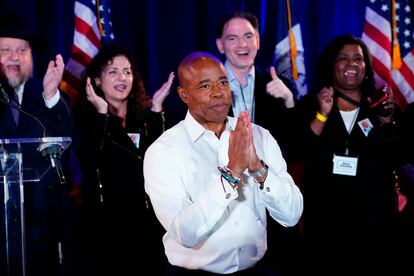Will New York City’s plan against rising gun violence work?
The spike in shootings and fatal robberies is posing a major challenge to the new mayor, Eric Adams, an ex-police captain who has promised to get tough on crime


Authorities in New York City are under pressure to address the rise in violent crime. In line with the rest of the country, the city has experienced a spike since the beginning of the coronavirus pandemic, and the trend appears to have accelerated in recent weeks. Mayor Eric Adams has promised to crack down, but his pledge has been met with criticism from left-leaning Democrats and social activists.
The context now is different from the violence-ridden days of the 1980s and 90s. Following the rise of the Black Lives Matter movement, police excesses are in the spotlight. Safety concerns are dragging down the economic recovery and fueling inequality in the neighborhoods hardest hit by the pandemic: in what amounts to a vicious circle, the underprivileged areas generate and suffer violence, which later spreads to other neighborhoods.
Just four weeks into the job, Mayor Adams is now confronted with a crisis that could well come to define his term in office. A former police captain, Adams won the election on a promise of increased safety, but with each passing day his pledge is coming up against the lethal reality of the city’s streets. There have been murders, robberies ending in loss of life, even a baby who was wounded by a stray bullet.
The killing of two police officers responding to a call two weeks ago became a turning point in Adams’ short tenure. The mayor has made proposals to deal with the violence that rely chiefly on stepping up police presence by bringing back anti-gun police units that were used until 2020. His plan has been criticized by those who wish to defund the police – an idea that has gained a lot of traction ever since the killing of George Floyd by a police officer in May of that year.
Gun violence is also affecting other US cities, but New York is a showcase to the world, and a stray bullet at rush hour in Times Square is not the best message to send out for a city seeking to recover from the effects of the pandemic.
On Thursday, Adams was due to host President Joe Biden in New York City to discuss “an integral strategy to fight violence.” On Monday, the president put forward a proposal that did not sound very different from the mayor’s, and which focused on hiring more police officers and investing in community violence intervention programs. A social spending plan that is currently stuck in the Senate would release $5 billion (€4.4 billion) on these programs, while some Democrats, including the influential Senate majority leader Chuck Schumer, are suggesting that the only way to prevent gun sales and related crimes is through federal intervention.

In 2020 there were 1,530 shootings in the city, more than twice the previous year’s figure. And in 2021 there were 1,877, the highest number in decades. Last year, gun-related arrests in the city, whose laws on gun possession and use are among the strictest in the US, rose 6% from 2020 and 34% from 2019. The so-called “Iron Pipeline,” a route used to smuggle weapons from southern and western states to the Big Apple, is operating at full speed, and police attempts at getting people to surrender their guns in exchange for free iPads and cash, no questions asked, have met with little success.
In early January, a 19-year-old employee at a Burger King was shot in the chest and killed in a robbery involving just over $100 (€88) in the cash register. Sam, the owner of the adjoining pizzeria, located in East Harlem, confirmed that there is a sense of fear in the predominantly Latino neighborhood. “Some businesses are closing early and we are considering it,” he said. “It’s taken us so much effort to overcome the pandemic, and many of us feel this could be the final blow. People are going out less. Let’s hope that measures are taken right away; as a matter of fact, you can already see more police, but that always happens after the fact.”
The mayor’s plan is nearly entirely lacking in evidence to back his tough-on-crime interventionsAlex Vitale, professor of sociology at Brooklyn College
For some, the rampant crime can be explained by the effects of the pandemic, which exacerbated inequality – the unemployment rate in New York was 8.8% in December, more than twice the US average of 3.9%. “The pandemic has caused a tremendous economic dislocation and considerable agitation in New York. With unemployment of 15% among workers who did not go to university and African Americans, and 24% among young people between the ages of 18 and 24, many neighborhoods will remain fractured and stretched to the limit until more is done to restore job opportunities,” said James Parrott, director of economic and fiscal policies at The New School’s Center for New York City Affairs. “As a city, we cannot afford to sit and wait for the job market to recover by itself, because that will take years.”
The mayor is targeting the youngest population segment for prevention programs, specifically the 250,000 youths between the ages of 16 and 24 who neither work nor study. Just like former state governor Andrew Cuomo, Adams is proposing temporary job programs to keep these youths busy during the summer months. The plan has been described by many as inefficient because it falls short. There is also a political controversy over the legal response to the spike in violence, particularly with regard to Manhattan’s new district attorney. “There have been four epidemics of gun violence since the 1960s. They go up and down in predictable ways, often in correlation with public health crises [such as the crack epidemic]. Historically, applying the law has played a small role in its disappearance,” said Jeffrey Fagan, a law professor at Columbia University. “The policies of mass arrests, a common response to past epidemics, did little to stop the flow of weapons. Mayor Adams is right to focus on fighting the traffickers.”
Alex Vitale, a professor of sociology at Brooklyn College and coordinator of its Policing and Social Justice Project, does not believe that the newly announced measures will be efficient. “The mayor’s plan is nearly entirely lacking in evidence to back his tough-on-crime interventions,” he said, adding that the plan is based more on political issues than empirical facts. “It runs the risk of recreating the conditions that gave rise to Black Lives Matter, such as the killing of Amadou Diallo by an anti-crime unit.” In 1999, an unarmed immigrant from Guinea named Amadou Diallo was shot 41 times outside his home. All four officers were acquitted, and the case helped fuel the movement against police brutality. The risk of excessive police intervention will now be under greater surveillance than ever.
Tu suscripción se está usando en otro dispositivo
¿Quieres añadir otro usuario a tu suscripción?
Si continúas leyendo en este dispositivo, no se podrá leer en el otro.
FlechaTu suscripción se está usando en otro dispositivo y solo puedes acceder a EL PAÍS desde un dispositivo a la vez.
Si quieres compartir tu cuenta, cambia tu suscripción a la modalidad Premium, así podrás añadir otro usuario. Cada uno accederá con su propia cuenta de email, lo que os permitirá personalizar vuestra experiencia en EL PAÍS.
¿Tienes una suscripción de empresa? Accede aquí para contratar más cuentas.
En el caso de no saber quién está usando tu cuenta, te recomendamos cambiar tu contraseña aquí.
Si decides continuar compartiendo tu cuenta, este mensaje se mostrará en tu dispositivo y en el de la otra persona que está usando tu cuenta de forma indefinida, afectando a tu experiencia de lectura. Puedes consultar aquí los términos y condiciones de la suscripción digital.
More information
Últimas noticias
Most viewed
- Sinaloa Cartel war is taking its toll on Los Chapitos
- Oona Chaplin: ‘I told James Cameron that I was living in a treehouse and starting a permaculture project with a friend’
- Reinhard Genzel, Nobel laureate in physics: ‘One-minute videos will never give you the truth’
- Why the price of coffee has skyrocketed: from Brazilian plantations to specialty coffee houses
- Silver prices are going crazy: This is what’s fueling the rally










































